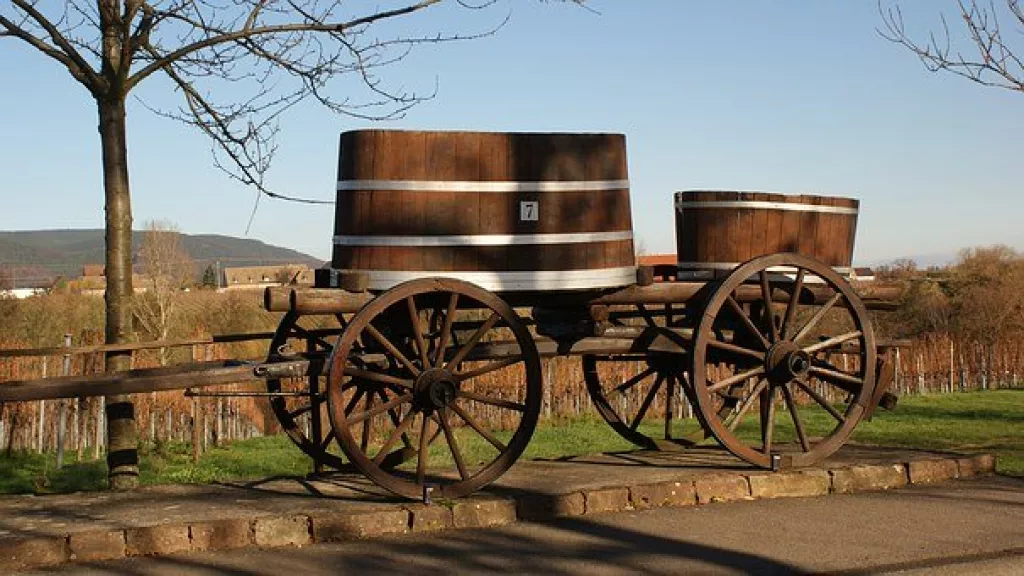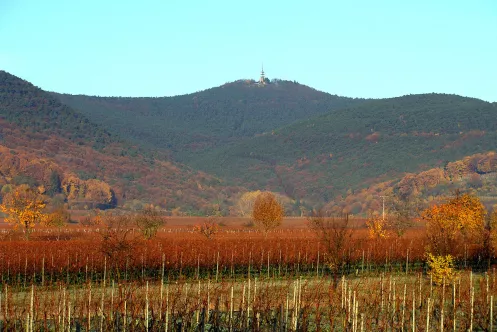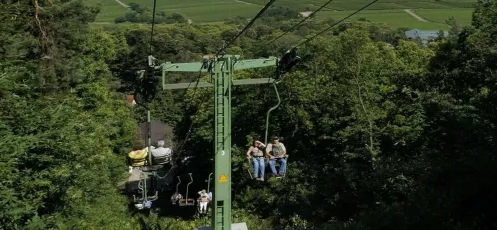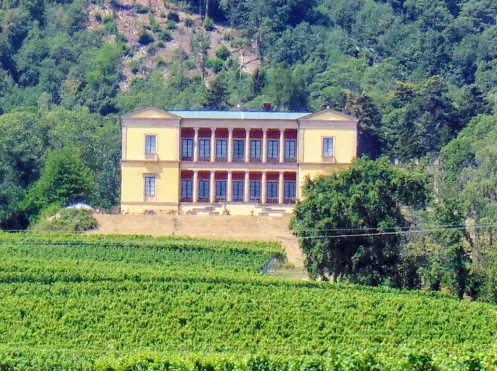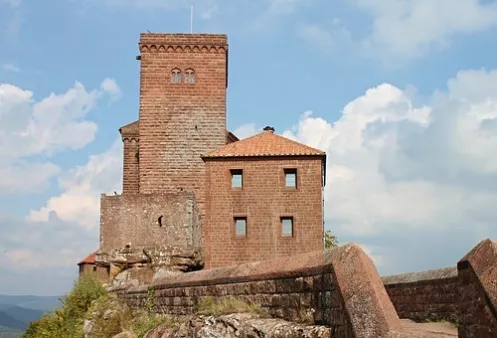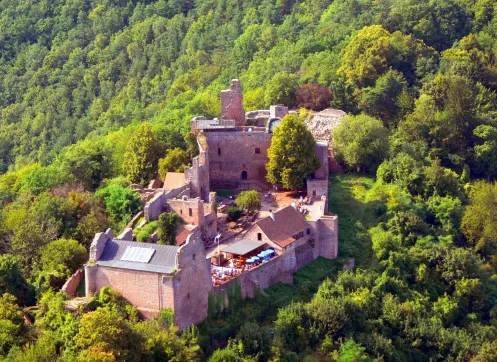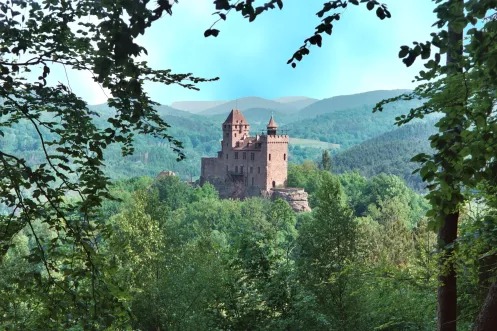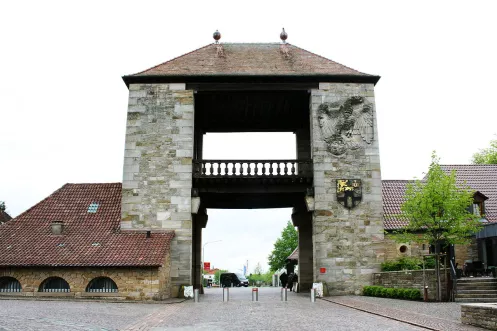The "lower" half of the Wine Route
The people of the Southern Palatinate are said to have a special ease in taking life as it is. Whether this is due to the fact that the region has always been closely intertwined with its French neighbors, both in times of war and peace, is something you can judge for yourself.
The landscape seems more expansive than at the "Mittelhaardt", as the Palatinate Forest at the Southern Wine Route begins to rise further west. Everything seems a bit more rural and dreamy. "Romantic" is something we're reluctant to call it, because so many regions describe themselves that way. But it fits well for the Southern Wine Route.
Trifels Castle near Annweiler, together with the many other castles, seems to watch over the fact that the idyll in the well-known wine villages like Rhodt, St. Martin or Edenkoben is not disturbed. Urban bustle prevails in Landau, the center of the region.
We have put together a few suggestions for a day trip to the "SÜW" - as we call it and as their car plates say. Have fun in the "South"!
Große Kalmit near Maikammer
The "Große Kalmit" near Maikammer is with 673m the highest mountain in the Biosphere Reserve "Pfaelzerwald" and after the "Donnersberg" the second highest peak of the Palatinate. The mountain is located on the "Haardt", the eastern edge of the Palatinate Forest. From the terrace on the summit of the Kalmit, there is a good view to the east into the Upper Rhine Plain, about 500m below, with the local communities of Maikammer and St. Martin close to the mountain. Over the plain, the view reaches as far as Ludwigshafen, Mannheim and Speyer.
Rietburg chairlift near Edenkoben
From the valley station, near "Villa Ludwigshoehe", the chairlift takes you in comfortable double chairs in eight minutes up to Rietburg Castle, which was built around 1200 a.c.. After you have mastered a height difference of 220m, you can enjoy a panoramic view from the panoramic terrace of the former robber baron's castle Rietburg over the Rhine Plain, the largest contiguous wine-growing area in Germany, the cathedrals of Worms and Speyer, and the slopes of the Odenwald and the Black Forest .
Villa Ludwigshoehe near Edenkoben
The Villa Ludwigshoehe was the "Italian-style" summer residence of the Bavarian King Ludwig I in the Palatinate. Surrounded by sweet chestnut trees and vineyards, with a view of the wide Rhine Plain, a decidedly cool classicist building with a shady inner courtyard was created on a square floor plan. In addition to the rich artistic and handcrafted interiors of the stately chambers and social rooms, the kitchen, which has been preserved almost unchanged, is fascinating as a closed, unified ensemble of rooms. At Ludwig's express wish, Villa Ludwigshöhe has no garden or park. The land around the villa, with its vineyards, fields and forest, was like "a great garden" for Ludwig.
From the beginning of 2020 until the start of the 2022 summer season, Villa Ludwigshoehe will be closed for renovation work.
Landau Zoo
Since 1904 - over 100 exotic species with over 900 animals.
The zoo is a five-minute walk from downtown Landau. Experience the animals in the monkey house and parrot house as well as the free-flight hall in the 4.5-acre park. Visit the Humboldt penguins, African ungulates, big cats, emus, and Bennett kangaroos.
On the forest path to the tiger enclosure is a nature trail, which also provides information on native songbirds. In addition to its function as a place of recreation, Landau Zoo is strongly involved in the fields of species conservation, environmental education and research.
Trifels Castle near Annweiler
The most famous castle in the Palatinate is impressively situated on a narrow rocky reef, which forms the summit of the 500m high Sonnenberg. The castle was first documented in a deed of donation from 1081. In the High Middle Ages, Trifels Castle protected the imperial land around Annweiler. In the 12th and 13th centuries, the German emperors and kings kept the imperial regalia at the castle.
The fortress was the state prison during the Staufer period. The most famous prisoner was none other than the English King Richard the Lionheart. After paying a considerable ransom, he was released on 04.02.1194 after almost a year of captivity.
Madenburg near Eschbach
The castle ruin Madenburg is one of the largest and oldest castle complexes in the Palatinate. It was built in the early 11th century, most likely as an imperial castle. With a length of about 180m and a width of about 50m, the Madenburg is the largest castle complex in the Southern Palatinate. It is located 250m above the village of Eschbach on a rocky spur of the Rothenberg.
All three castle gates, the ring wall, the Zwinger, the well and the foundation walls of the Pallas and the bower in the outer and upper castle are still preserved. You can reach a vantage point in the upper castle via the restored stair tower. From the Madenburg you have a magnificent view over the Rhine plain, the Palatinate and the Wasgau.
Berwartstein Castle near Erlenbach
Berwartstein Castle, first mentioned in a document in 1152, experienced eventful times in the Middle Ages as a robber baron's castle under Hans Trapp. Berwartstein stands at an altitude of about 280m on a hilltop south of the village of Erlenbach. The castle was rebuilt in the 1890s about 300 years after it was destroyed by lightning and is still the only inhabited castle in the Palatinate. Berwartstein is one of the many castles in the Dahner Felsenland, the region in the Palatinate Forest that borders the Southern Wine Route just to the west. What distinguishes Berwartstein from all the other castles is the ascent chimney on the southeast side of the castle rock. This chimney is unique in its geological makeup and once provided an easily defensible entrance.
German Wine Gate in Schweigen-Rechtenbach
The German Wine Gate in the southern Palatinate wine-growing community of Schweigen-Rechtenbach is a listed gate building with outbuildings. Since 1936, the gate marks the southern beginning of the German Wine Route.
The 19m high wine gate is built of sandstone in the neoclassical style. At a height of 7.6m, a horizontal wooden gallery extends across the gateway, which is accessible on its eastern side by a three-flight stone staircase. From the gallery you have a good view of the wine road running below and the nearby mountains of the Wasgau. Another viewing platform at a height of about 10 meters opens the view to the east in the direction of the Rhine Plain up to the Black Forest.
